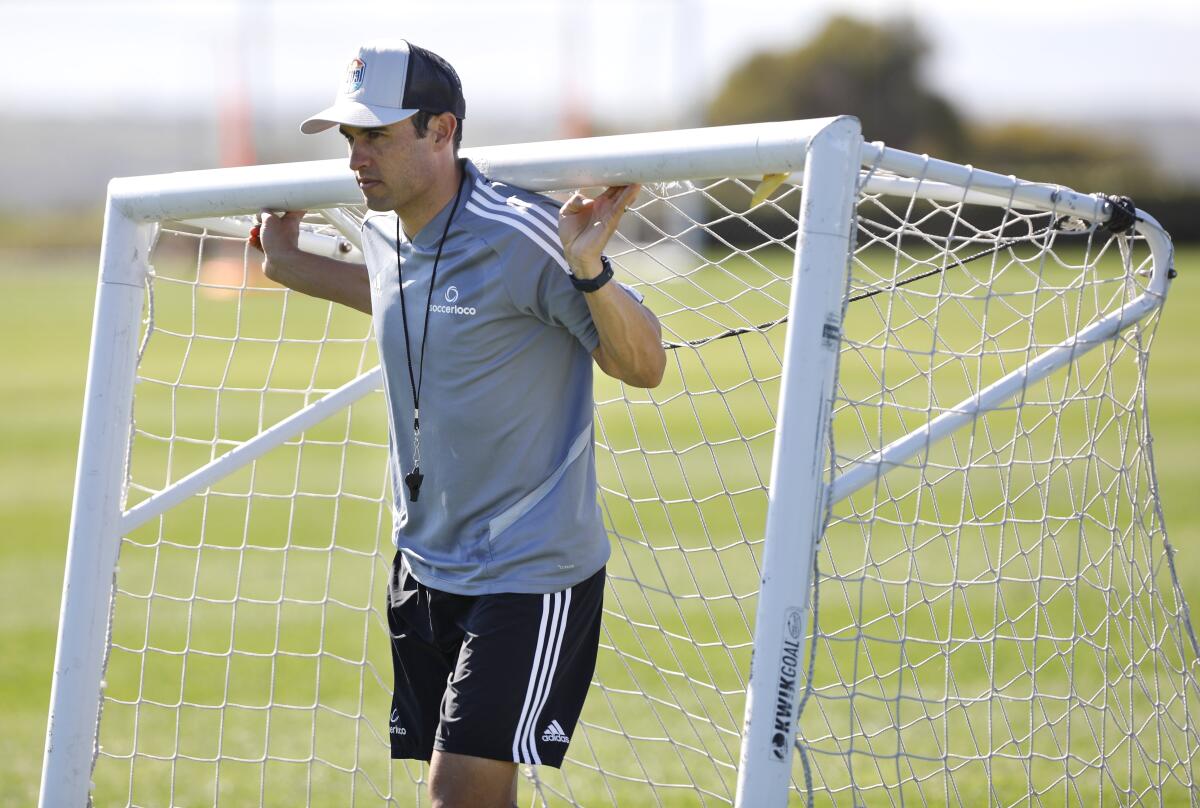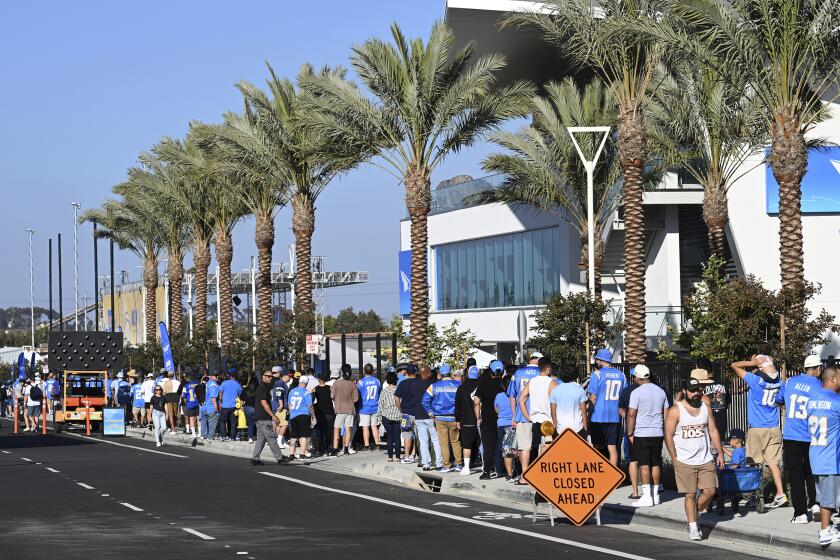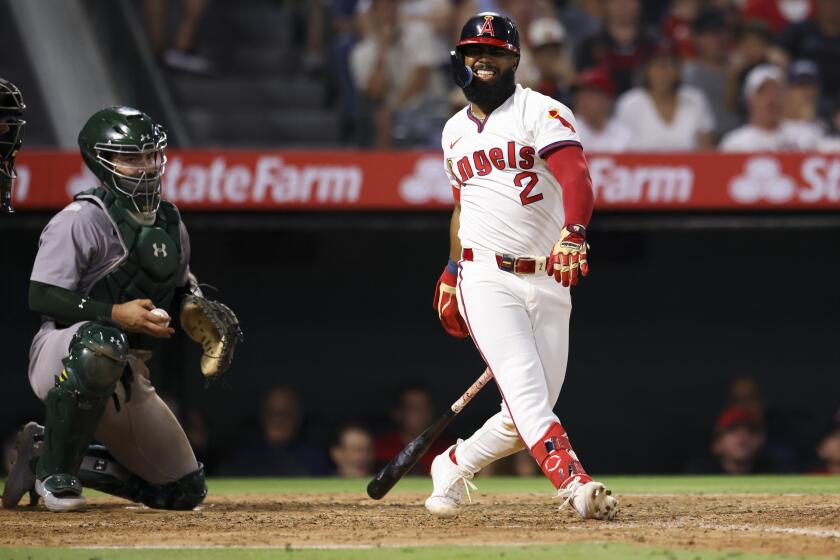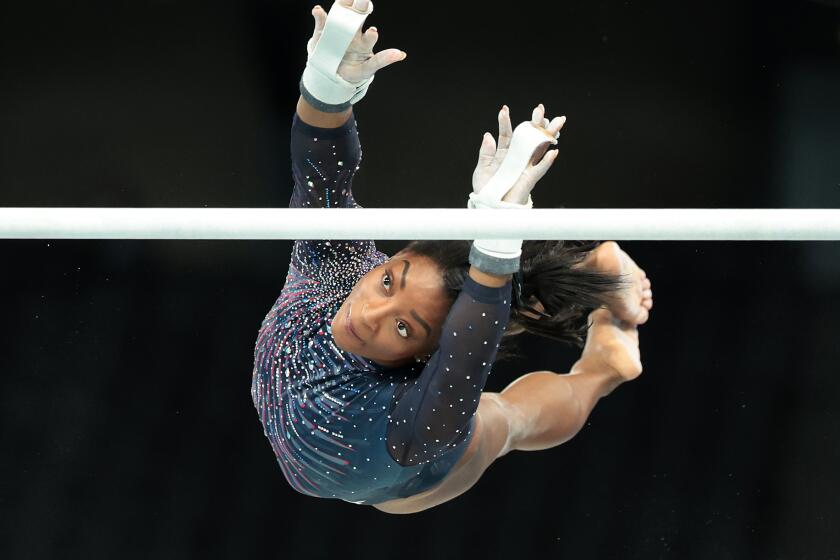Soccer newsletter: Checking in with the USL

Hello, and welcome to another edition of the L.A. Times soccer newsletter. I’m Kevin Baxter, The Times’ soccer writer, and we have a lot of news today, but we’ll begin with a peek at the Orange County Soccer Club and the rest of USL Championship. Because while everybody and every league has suffered during the COVID-19 shutdown, the pain has been particularly acute for the second-tier USL Championship, which was carrying a ton of momentum into 2020 before being forced to shut down less than two weeks into its schedule.
OCSC helped christen the 10th season of the rapidly expanding league last month, playing the El Paso Locomotive to a scoreless draw at the Orange County Great Park. Six days later the league – and the rest of pro sports in the U.S. – stopped play and OCSC has no idea when it may play again.
The indefinite suspension comes at a bad time for the league, which has grown from six to 35 teams over the last decade. Expansion fees have gone from $150,000 to $10 million over that span, total attendance was expected to top 3 million for the first time this season and the league had a new three-year TV deal with ESPN that would have tripled the number of televised games.
More than $1 billion in stadium construction has either been pledged or is already underway.
Now all that has been put on pause. And given the delicate finances of clubs at all level of the U.S. soccer pyramid, it’s uncertain what the league will look like when play resumes.
“This is an extremely tough time for our league. We can’t minimize that. It hurts,” Jake Edwards, the league president, said. “But I think even in these dark times we all believe our brightest days are still ahead of us.”
Enjoying this newsletter? Consider subscribing to the Los Angeles Times
Your support helps us deliver the news that matters most. Become a subscriber.
Consider what the USL Championship may have lost. Team owners this season included former U.S. national team stars Landon Donovan, also the coach and executive vice-president with the San Diego Loyal; and record-setting goalkeeper Tim Howard, a player and sporting director at Memphis 901. Former Dodger pitcher Brandon McCarthy and musician Diplo are co-owners of the team in Phoenix and Spanish World Cup champion David Villa is a part owner of Queensboro, which is still scheduled to play its first game next season.
With expansion fees in the top-flight MLS passing $325 million, Edwards says the USL – which also includes the 94 teams in USL League One and League Two – has continued drawing interest from investors who see the potential of soccer in the U.S. but can’t pull a third of a billion dollars together.
“There was obviously incredible buzz about everything that was going on,” said Oliver Wyss, Orange County’s general manager.
The league has deep roots in Orange County’s Great Park, where the OCSC plays in one of the league’s most attractive stadiums.
In 2016 investment manager James Keston paid about $5 million for the Orange County Blues, rebranding the team and moving it to a new 5,500-seat home on the site of the former Marine Corps air station. Two years later, behind a 20-goal season from Thomas Enevoldsen, the team made it to the Western Conference final.
With Enevoldsen, who came to the USL from Denmark in hopes of landing an MLS job, returning to Orange County this season, third-year manager Braeden Cloutier, a former coach in the Galaxy academy, felt he had a team that could compete for a title.
Instead his team has been banned from training through at least May 3, a prohibition that is likely to be extended.
For Wyss, the crisis has allowed the team to show that it is more than just a soccer club. Keston hasn’t reduced the staff and apparently has no plans to do so – although plans are always subject to change.
“Right now you have to make sure that your staff, your players, the front office, the fans, the community is safe and healthy because we all have to contribute to what is going on right now,” Wyss said. “Our optimism has not changed. Of course it’s frustrating because you don’t have a timeline when you could start again.
“But soccer will come back. And when it comes back we want to be 100%.”
Toward that end Wyss said the coaching staff has been in daily contact with the players, who have been working out by themselves. Wyss, too, has been keeping busy.
“To be honest there hasn’t been one dull moment,” he said. “These times allow you to work on every detail of the organization that you maybe don’t have as much time [for] during the season. It’s ongoing coaching education. It’s player development. It’s better youth player profiles, your scouting. Then there’s obviously a lot of conversations from a league perspective, what is the plan.
“So no, I haven’t had the chance to watch Netflix.”
Many of those conversations with Edwards and the rest of the USL leadership have centered on when the league might come back and what it might look like when it does. Several public health officials have said they don’t envision large crowds being permitted to gather in stadiums in California for several months. But when the state begins the slow process of opening up, the USL Championship will probably be confronted with the choice of playing in empty stadiums.
“Ultimately it’s either you’re playing in front of fans or without the fans,” Wyss said. “I think everybody’s in agreement that playing without the fans is not the same. But I think it’s also important to play games. There’s obviously clubs in the USL who heavily depend on the fans and the ticket sales. And that leads into sponsorships and everything else.
“Coming back without fans, would it be detrimental to the league? No. It would just be a different way of watching games. But ultimately we all want the fans to be there because that’s what pro sports is all about. That atmosphere makes the game so unique.”MLS looking at plans that make both dollars and sense
The MLS is also strongly considering a plan that would see its season resume in empty stadiums, although that won’t happen for at least another six weeks since the league said Friday it was suspending play for a third time, this time until June 8. MLS teams are under a training moratorium through April 24, though that date is certain to be pushed back this week as well.
MLS stopped play March 12, after two games, and has publicly said it is committed to having its 26 teams complete their full 34-game schedule. Privately, however, commissioner Don Garber is looking at a wide range of options including a drastic one that reportedly would see games resume in September with the MLS Cup played a neutral site early next year.
Also privately some players have said they are preparing for the season to be scrapped altogether.
It’s difficult for any league to come up with anything close to a concrete plan since the COVID-19 landscape continues to change, with outbreaks cropping up in some places while the curve flattens in others. And MLS, with teams in 17 states and three Canadian provinces, can’t reopen until it’s safe to travel and play in all 20 of those places.
“There’s different restrictions in different parts of the country. It makes it a challenge to generalize things to maybe come to a conclusion that you can put everybody together and just play as normal,” Galaxy general manager Dennis te Kloese said. “We have to be creative.”
But as long as MLS continues insisting it will play a full schedule, people with season tickets will continue having trouble getting a refund. The reason? No games have been canceled. And until they are canceled, the league says, fans should assume they will be played and teams should be allowed to keep their money.
So it isn’t in the league’s interest to make any public pronouncements about cancellations, though that is undoubtedly being considered.
“Major League Soccer remains focused on exploring a wide variety of formats for playing the entire 2020 season,” the league said in a statement Friday.
But making that statement true, Te Kloese said, is “going to be very challenging.”
Another sign that MLS is considering a reduced schedule came last week from ESPN, which reported the league and the players union are discussing “significant salary cuts” of up to 50% if games are canceled.
That percentage could change based on games played and games played without fans in attendance. Players making less than $100,000 this season would not be affected. The plan would allow the league to reduce its total player payroll by $150 million, the ESPN story said. Based on salary figures released by the MLSPA last year, and with expansion sides Miami and Nashville joining this season, the total league payroll is estimated to be north of $310 million.
“We are seeking to work collaboratively with the [players union] to find a solution that provides a safety net for all players, opportunity to earn full salary in the scenario where all matches are played with fans, and in particular provides protection for the players at the lower end of the salary scale,” the league said.
MLS has already cut the salaries of some executives and front office personnel, including Garber and deputy commissioners Mark Abbott and Gary Stevenson, by 25%. Other league employees saw their salaries reduced by 10% to 20%.Driving to keep the game alive in Denmark
Most of the world’s soccer leagues have settled on three options for handling the COVID-19 pandemic. You can play games in front of fans, no matter the risks, as teams in Nicaragua, Belarus, Burundi and Tajikistan are doing. You can play in empty stadiums, as Taiwan is doing and the German Bundesliga is preparing to do. Or you could suspend the season and wait for the danger to pass.
Now Midtjylland, leaders of the Danish Super League, have come up with a fourth option. Last week the team unveiled a plan to play drive-up soccer, allowing as many as 2,000 automobiles to park around the stadium so the fans inside can take part in game-day activities from the safety of their cars.
The Danish Super League is currently suspended and no fans will allowed in the stands until at least August. But they can still enjoy the game-day feel from the safety of their own traffic jam.
“We are working hard to create the best possible experience,” Midtjylland marketing and support director Preben Rokkjaer said in a club statement. “[Drive-in football] will go a long way to giving something back to the region and our many loyal fans.”
Rokkjaer said the club has gone to local authorities with their idea, which would include setting up big screens in the parking lots outside the MCH Arena, allowing fans to watch the match taking place inside. The team would partner with a local radio station to provide live commentary for fans to listen to on their car radios.
When the Danish Superleague suspended its season March 10, Midtjylland had a 12-point lead atop the table with just two games left on its schedule.Youth will be served … just by a different server
U.S. Soccer’s decision to shut down its development academy last week was both welcome and unsurprising. But the announcement minutes later than MLS would fill the resulting void was unexpected.
The academy wasn’t a physical place but an unwieldy nationwide umbrella of hundreds of boys’ and girls’ teams in several age groups. The program was established in 2007 to correct perceived shortcomings in a disjointed player development infrastructure by creating a system through which all the top players would pass. And with every MLS team also fielding an academy there would be, for the first time, a clear pathway to a professional career.
The DA would have 10-month seasons, better practice-to-game ratios and, supposedly, a more competitive environment in which the best players in a particular region would face one another more frequently.
But in practice it largely failed to live up to that promise. And when, in 2012, academy players were banned from playing for their high school teams, many prep programs were decimated.
The huge downside was worth the limited upside.
MLS, whose academy programs were part of the DA, were among those complaining about the low level of competition and reportedly began discussing an overhaul of program more than a year ago.
However in a statement announcing the closing of the development academy, U.S. Soccer said its decision was directly related to the financial impact of the coronavirus.
“The extraordinary and unanticipated circumstances around the COVID-19 pandemic have resulted in a financial situation that does not allow for the continuation of the Development Academy into the future,” the statement said. “We know that suddenly discontinuing a program that has been with U.S. Soccer for many years is shocking, but these unprecedented times required taking action now.”
That doesn’t pass the sniff test though since COVID-19 didn’t begin impacting sports until six weeks ago. Are we really to believe U.S. Soccer decided, in just six weeks, to shut down a nationwide program serving thousands of players? Or that MLS was able to finalize its replacement plan in even less time? Clearly this passing of the torch has been in the works for some time.
U.S. Soccer, which is facing a number of potentially costly legal challenges, including a gender-discrimination suit filed by its World Cup champion women’s team, anticipated spending $12 million for the academy in 2021, according to a report in The Athletic.
The new MLS-administered system could be broadened to include teams from the USL, which last summer announced it would be forming an academy league for its member clubs. Each team is to field one team composed of prospects from the U-15 through U-19 age groups.
“We’ll be very interested in the restructure of a lot of the youth pathways,” said Wyss, whose team has been very aggressive in signing and developing young players. “That’s probably overdue.”
This will be a story worth following as it unfolds.
Podcast
Don’t miss my weekly podcast on the Corner of the Galaxy site as co-host Josh Guesman and I discuss the Galaxy each Monday. You can listen to the most recent podcast here.
Quotebook
“He said ‘If you are going to come here to go to the beach or take a walk in Hollywood, just say so. I have $300 million on my account, an island, I don’t need this for anything. The first one who says something to me, I will kill him.’ ”
Former Galaxy midfielder Joao Pedro, in the Portuguese sports tabloid Record, on ex-teammate Zlatan Ibrahimovic
Until next time...
Stay tuned for future newsletters. Subscribe here, and I’ll come right to your inbox. Something else you’d like to see? Email me. Or follow me on Twitter: @kbaxter11.
Go beyond the scoreboard
Get the latest on L.A.'s teams in the daily Sports Report newsletter.
You may occasionally receive promotional content from the Los Angeles Times.




